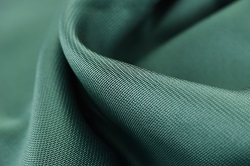Major Faults in Weaving Fabric

The fabric industry is a very large and important part of the clothing industry. The production of fabric starts with the manufacturing of yarns. Fabrics, diverse in types, share a common origin: they’re woven from yarns. They can consist of natural, synthetic, or blended fibers and can be woven or knitted. The fabric type is dictated by the fiber quality, weave, and manufacturing process. These versatile materials find applications in clothing, upholstery, drapery, bedding, and various household items like curtains and tablecloths.
Grey fabric, unlike dyed fabric, retains its natural white color without any variation. Its adaptability shines through its capacity to serve multiple purposes, from crafting clothing to making curtains and bed sheets. This distinction sets it apart from white fabric, offering a broader range of applications. Fabric faults are the most common problem that a fabric can have. Fabric faults can occur as a result of many factors. Factors influencing fabric quality encompass its overall quality, handling during production, and the dyeing process it underwent. Fabric faults are a major concern for any fashion designer. The fabric may not be perfect, but these faults can make the garment look shabby and cheap.
The main types of fabric faults are:
Miss Pick
Starting Mark
Floats
Cracks
Coarse Pick
Coarse End
Selvedge Defect
Lose End
Sizing Stain
Increase Density
Complete Descriptions of Major Faults in Weaving Fabric
What is Miss Pick in Fabric
This defect occurs when one or more weft yarns are skipped or missed during the weaving process.
Selvedge defect:
This occurs when there are missing weft yarns at one or both edges of the cloth due to issues with the warp thread.
What is a Starting Mark in Fabric
A starting mark is when a weft thread starts from an incorrect position on the warp beam. or
Starting marks occur when an indentation appears on one side of the fabric due to the use of a starting shuttle solely at one end for initiating weaving, rather than employing shuttles at both ends.
What are floats in Fabric
Floats are yarn sections that extend along the selvedge of a fabric, formed when there’s insufficient space on either side during weaving to secure them in place.
What are Cracks in Fabric
Various issues such as excessive tension during weaving or inadequate drying post-washing can cause cracks to appear in the fabric.
What is Coarse Pick in Fabric
A weaving or knitting machine can cause a coarse pick, inadvertently grabbing threads from different parts of the fabric and weaving them into the material.
What is Coarse End in Fabric
When yarn woven into the fabric isn’t adequately trimmed off from the loom, it results in what’s termed as a coarse end. This can cause problems such as fraying or unraveling of threads on the edge of cloth.
Selvedge Defect in Fabric
Selvedge defect is a result of poor-quality control during weaving or knitting process. Improper trimming of one side of a fabric leaves threads on that side, resulting in this occurrence.
Lose End in Fabric
Machine malfunctions during the weaving or knitting process cause loose ends, leaving threads hanging on one side of a cut piece.
Sizing Stain in Fabric
Treating fabric with a sizing agent prior to weaving results in a fabric fault termed a sizing stain. Either too much or too little sizing agent can cause it. The most common way to identify a sizing stain is by looking at the back of the fabric. If there are small, white spots on the back, then it is likely that there was too much sizing agent applied to the fabric and it will shrink more than other fabrics in the wash. If there are large, white spots on the back, then it is likely that there was not enough sizing agent applied to the fabric and it will not shrink as much as other fabrics in a washing machine.
Increase Density in Fabric
Increase Density. This problem indicates that fabric has more picks or ends at some certain piece of fabric than the required standards.